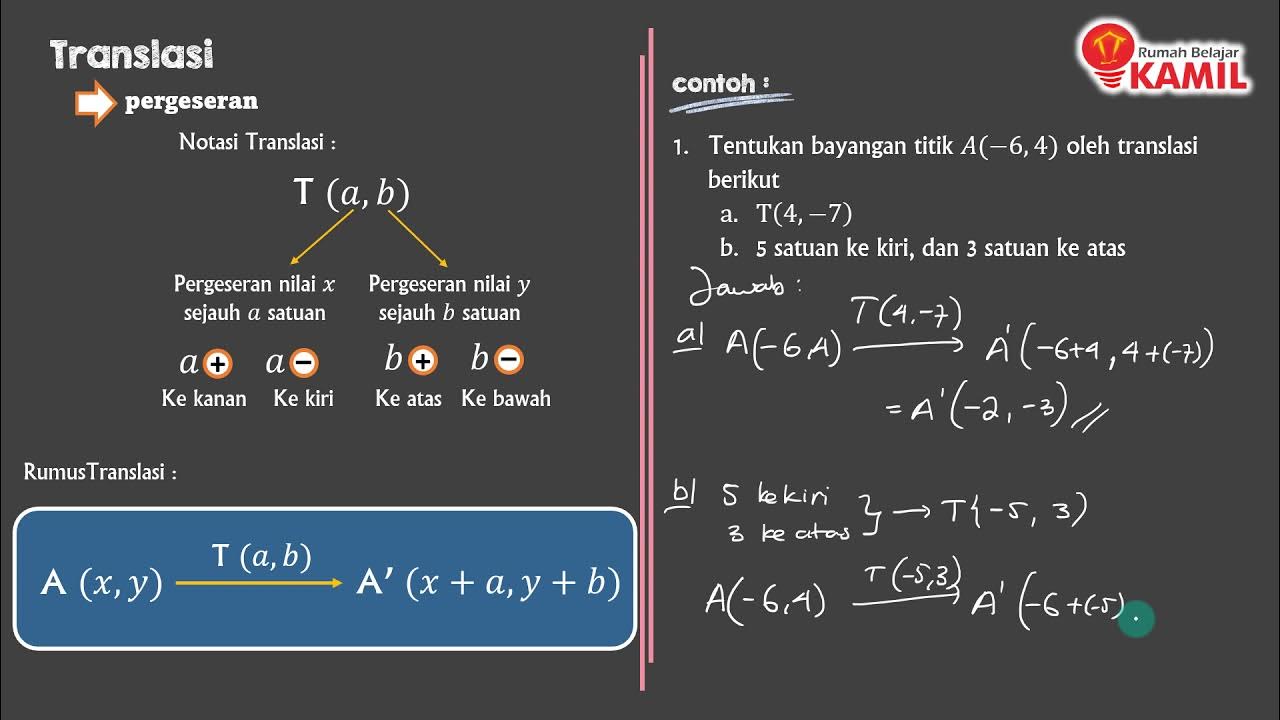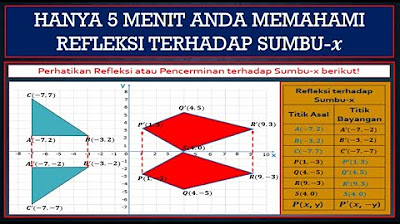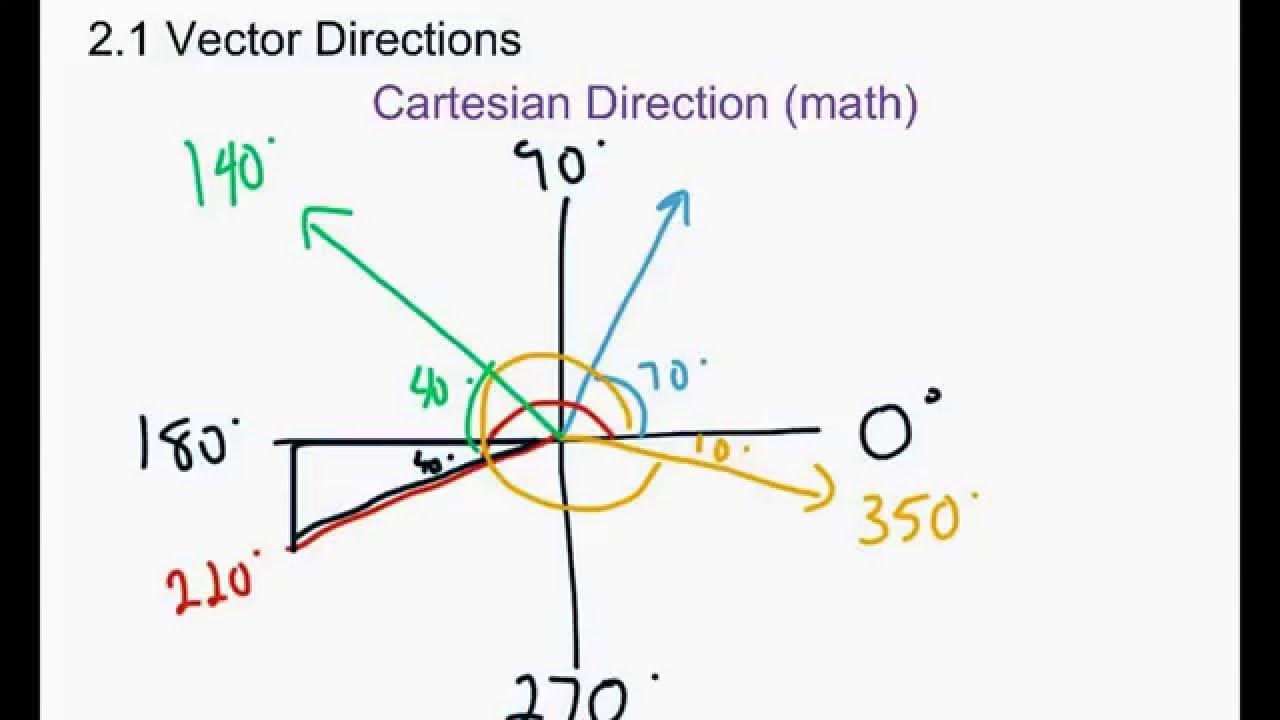Matematika kelas 9 : Transformasi Geometri (part 3 : Rotasi I)
Summary
TLDRIn this educational video, Kak Kamil introduces the concept of rotation (rotasi) in geometry, focusing on its applications in the Cartesian coordinate system. The video covers how rotation involves turning a point by a certain angle and direction around a fixed point, the center of rotation. Different rotations are explained, including 90°, 180°, and 270° rotations, both counterclockwise and clockwise. Practical examples demonstrate how to calculate the coordinates of a point after rotation, using formulas to simplify the process. The video also touches on combined transformations such as rotation followed by translation.
Takeaways
- 😀 Rotation is a transformation that involves turning a figure around a fixed point, known as the center of rotation.
- 😀 In geometry, rotation can be clockwise (negative angle) or counterclockwise (positive angle).
- 😀 A rotation of 90° counterclockwise changes coordinates from (x, y) to (-y, x).
- 😀 A rotation of 180° results in coordinates changing from (x, y) to (-x, -y), regardless of direction.
- 😀 A 270° counterclockwise rotation (or 90° clockwise) changes coordinates from (x, y) to (y, -x).
- 😀 The center of rotation is usually the origin (0,0), but it can also be any point, and the calculation adapts accordingly.
- 😀 To rotate a point by 90°, you swap the x and y coordinates and negate the new x value.
- 😀 For 180° rotations, the x and y coordinates are both negated to form the new coordinates.
- 😀 270° counterclockwise rotation can be achieved by rotating 90° clockwise, and vice versa.
- 😀 Combining transformations like rotation and translation is possible. For example, after rotating a point, it can be shifted by adding values to its coordinates.
- 😀 A detailed example demonstrated how to rotate points and apply formulas for different angles, helping clarify the rotation process.
Q & A
What is the definition of rotation in geometry?
-Rotation in geometry refers to the movement of a point around a fixed center, known as the center of rotation, through a specified angle. The point moves along a circular path, maintaining its distance from the center.
What is the significance of the center of rotation in geometric transformations?
-The center of rotation is the fixed point around which all other points rotate. In the script, rotations are discussed with respect to the origin (0,0) as well as other arbitrary points, such as (a, b), which can alter the final positions of points after rotation.
How does rotation in the counterclockwise direction affect the angle value?
-When rotation occurs in the counterclockwise direction, the angle (theta) is considered positive. This is consistent with standard mathematical conventions.
What happens when a point is rotated 90° counterclockwise around the origin?
-For a 90° counterclockwise rotation around the origin, the coordinates of a point (x, y) are transformed to (-y, x).
How do the formulas for rotation change for different angles?
-The formulas for rotation are as follows: For 90° counterclockwise, (x, y) becomes (-y, x); for 180°, (x, y) becomes (-x, -y); and for 270° counterclockwise, (x, y) becomes (y, -x). Rotations in the clockwise direction have equivalent formulas but with negative angles.
What is the relationship between 90° counterclockwise rotation and 270° clockwise rotation?
-A 90° counterclockwise rotation is mathematically equivalent to a 270° clockwise rotation. The result for both is the same.
How do we calculate the rotated coordinates of a point after a 180° rotation?
-After a 180° rotation, the coordinates of a point (x, y) are transformed to (-x, -y). This applies regardless of whether the rotation is clockwise or counterclockwise.
Can a 270° counterclockwise rotation be simplified using the 90° clockwise formula?
-Yes, a 270° counterclockwise rotation is equivalent to a 90° clockwise rotation. The transformation formula for a 270° counterclockwise rotation, (x, y) becomes (y, -x), matches the formula for a 90° clockwise rotation.
What are the steps for solving a problem involving rotation and translation?
-To solve a problem involving both rotation and translation, first apply the appropriate rotation formula to the point's coordinates. After that, apply the translation by adding the specified values to the x and y coordinates.
How do we reverse a given rotated coordinate to find the original point?
-To reverse a given rotated coordinate and find the original point, apply the inverse of the rotation formula. For example, for a 90° clockwise rotation, use the formula (y, -x) to find the original coordinates from the rotated ones.
Outlines

Dieser Bereich ist nur für Premium-Benutzer verfügbar. Bitte führen Sie ein Upgrade durch, um auf diesen Abschnitt zuzugreifen.
Upgrade durchführenMindmap

Dieser Bereich ist nur für Premium-Benutzer verfügbar. Bitte führen Sie ein Upgrade durch, um auf diesen Abschnitt zuzugreifen.
Upgrade durchführenKeywords

Dieser Bereich ist nur für Premium-Benutzer verfügbar. Bitte führen Sie ein Upgrade durch, um auf diesen Abschnitt zuzugreifen.
Upgrade durchführenHighlights

Dieser Bereich ist nur für Premium-Benutzer verfügbar. Bitte führen Sie ein Upgrade durch, um auf diesen Abschnitt zuzugreifen.
Upgrade durchführenTranscripts

Dieser Bereich ist nur für Premium-Benutzer verfügbar. Bitte führen Sie ein Upgrade durch, um auf diesen Abschnitt zuzugreifen.
Upgrade durchführenWeitere ähnliche Videos ansehen

Matematika Kelas 9 : Transformasi Geometri (part 1 : Translasi)

Transformasi Geometri [Part 2] - Translasi (Pergeseran)

Rotasi Terhadap Titik Pusat O(0,0) - Matematika Tingkat Lanjut SMA Kelas XI Kurikulum Merdeka

Hanya 5 menit anda paham Refleksi terhadap sumbu-𝒙

Distance Formula | Introduction to Analytic Geometry|

Physics 20: 2.1 Vector Directions
5.0 / 5 (0 votes)
